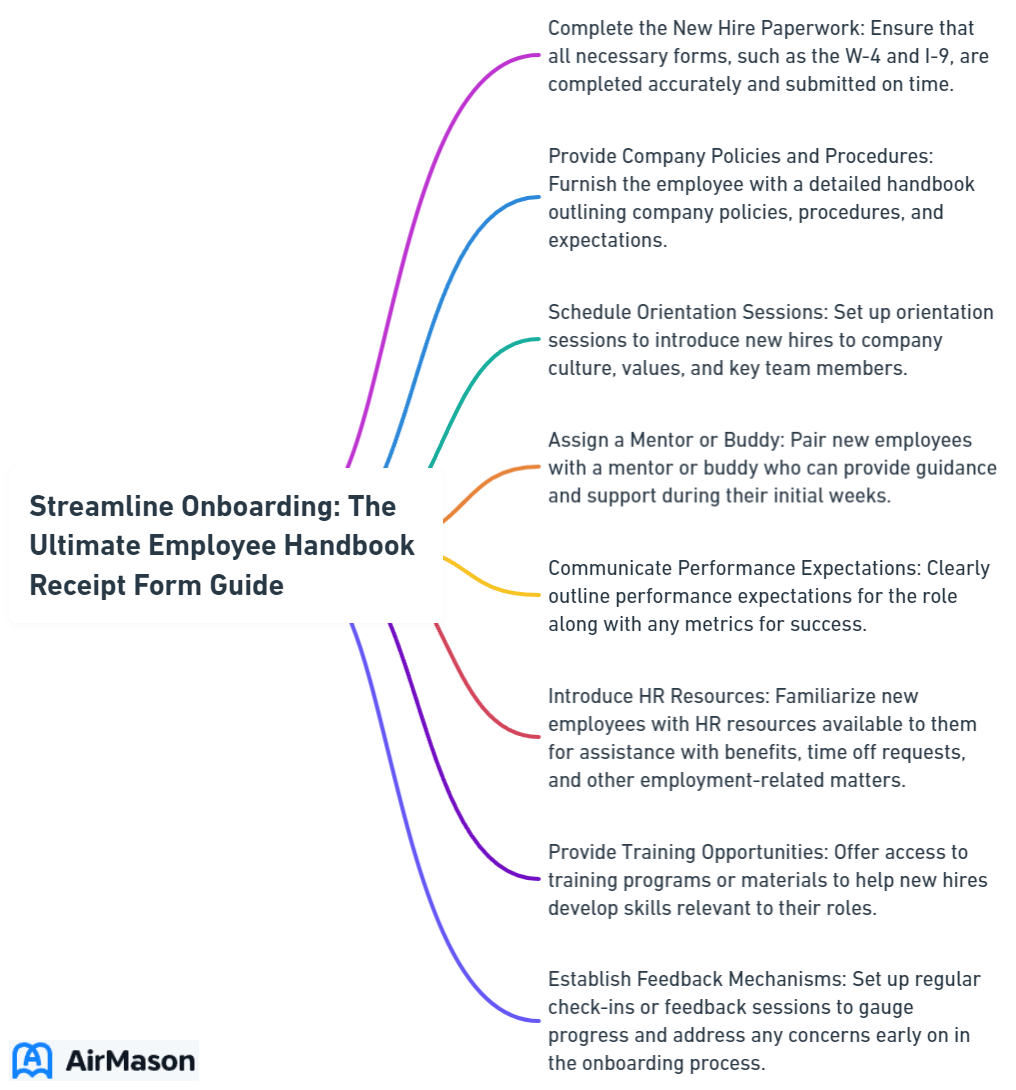
Creating an employee handbook receipt form is a key step to ensure that your workforce is on the same page regarding company policies. In this straightforward guide, we’ll show you how to draft and use these forms effectively, making it easy for your employees to acknowledge and adhere to workplace rules. Avoid any confusion or legal hassle by following our practical tips and insights.
Key Takeaways
- Employee handbook receipt forms are crucial for affirming that employees have received, understood, and agree to adhere to company policies, with the act of signing playing a fundamental role in legal and organizational compliance.
- An effective employee handbook receipt form contains core components such as a responsibility statement, a full understanding acknowledgment, a clear at-will employment clause, and comprehensive employee information that culminates in a signed acknowledgment of receipt and understanding.
- Regular maintenance and updating of employee handbook receipt forms and the accompanying handbook are essential for both legal compliance and ensuring all employees are informed about current company policies, requiring a combination of digital solutions for distribution and tracking, and clear communication strategies for updates.
Understanding Employee Handbook Receipt Forms

Far from being mere formalities, employee handbook receipt forms stand as a cornerstone for a company’s employee handbook. These documents are signed by employees to confirm that they have received, comprehended, and align with the company’s handbook, which outlines the policies, procedures, and expectations. This act of signing legally reinforces the content of the handbook, ensuring employees are cognizant of company policies and cannot claim ignorance.
These forms play a pivotal role in educating employees about the evolving nature of company policies, encompassing possible alterations to policies such as hours, wages, and conditions. Moreover, providing a copy of the signed receipt form to employees promotes transparency and accountability, contributing to a shared understanding of workplace expectations and establishing a compliant organizational culture.
Definition and Purpose
An Employee Handbook Acknowledgement Form is more than just a piece of paper; it’s a mutual understanding between the employer and the employee. It is a testament to an employee’s awareness and comprehension of the contents of the handbook. Far from just functioning as documentation, these forms aim to confirm that employees comprehend and consent to the company’s expectations, rules, and regulations as outlined in the handbook, establishing a lucid statement of expectations.
This form may particularly emphasize crucial policies such as the harassment policy. It also contains additional affirmations stating that the handbook does not conflict with the National Labor Relations Act (NLRA) and that it supersedes all previous versions of the handbook. This provides a clear understanding of the procedures outlined, creating a shared understanding between the employees and the employer.

Benefits for Employers and Employees
The employee handbook acknowledgment form provides benefits for both employers and employees. It helps employers to:
- Communicate their expectations
- Ensure that employees understand their rights and responsibilities
- Serve as a legal armor, ensuring that employees are informed about the company’s policies and procedures
- Provide a clear record of an employee’s understanding and agreement to the rules and guidelines in the event of disputes.
For employees, the acknowledgment form serves as a guide, enabling them to familiarize themselves with the content of the handbook. By signing the acknowledgment form, employees take responsibility for reading and adhering to company policies, promoting accountability within the organization. Moreover, the acknowledgment form aids in tracking when employees have received and understood policy updates, creating a culture of continued compliance. All these factors contribute to a safer and more regulated work environment.
Essential Components of an Effective Employee Handbook Receipt Form

An effective employee handbook receipt form, much like a well-balanced recipe, consists of several vital components that contribute to its overall efficacy. It should include:
- A clear statement of the employee’s responsibility to read and comply with policies
- An acknowledgment of full receipt and understanding of the handbook
- A statement clarifying that the employee handbook supersedes all prior practices, oral and written representations, or statements concerning employment terms.
An integral part of the form is a clear contractual disclaimer and at-will statement, where applicable, that reiterates that the handbook is not an employment contract. Furthermore, the form should make employees aware that the handbook can be updated by the HR department at any time, with or without notice.
Lastly, the form should gather essential employee information and include a detailed statement of understanding, complete with an acknowledgment signature section and the date of acknowledgment.
Handbook PDF
If you’re seeking a comprehensive resource for your needs, a handbook PDF can be an invaluable asset. This document serves as a digital compendium, offering convenient access to essential information at your fingertips. Whether you’re a student looking for study materials or a professional in search of reference material, a handbook PDF provides a compact and portable solution. With the flexibility to be accessed on various devices, it ensures convenience and accessibility anytime, anywhere. Additionally, handbook PDFs often offer features such as search functionality and hyperlinks, enhancing usability and facilitating efficient navigation through the content.
Employee Information and Acknowledgment Statement
The employee information form, akin to the first step of a journey, gathers crucial details like the employee’s full name, job title, employee ID or social security number, contact information, and department or location. But the journey doesn’t stop there. The acknowledgment statement is a key milestone. It confirms the employee’s awareness of the company’s policies, their receipt of the handbook, and their obligation to understand and comply with company policies.
This form serves as a transparent communication tool between employers and employees regarding the contents of the online employee handbook. It provides a platform for dialogue where employees can seek clarifications about policies.
This acknowledgment form includes:
- An acknowledgment and disclaimer, where employees acknowledge receipt
- Employee information
- Receipt date
- An at-will employment clause
It is a comprehensive document that encapsulates the company’s expectations, rules, and regulations.
Employment At-Will Clause
The at-will employment clause offers a definitive statement that it is neither a contract nor does it intend to create an employment contract. It reiterates that employment can be terminated by either the employer or the employee at any time, with or without cause or notice. The clause maintains that no individual in the company, except for only the president or a designated officer through a written document, has the authority to modify the employment at will status.
The employee handbook, along with the acknowledgment form, explicitly states that they do not create a contract of employment or promise continued employment. The inclusion of this at-will employment clause in the acknowledgment form serves to clarify the nature of the employment relationship, underlining its voluntary and indefinite duration.
Signature and Date Section

The form’s signature and date section mark the final lap of this journey. This section should have a designated area for the employee’s signature, printed name, and the date to confirm that they have received and understand the handbook. It should also include spaces for the employee’s printed name, signature, and date, and optionally, space for a witness’s name and signature.
An employee’s signature is more than just an autograph; it is a commitment from the employee to adhere to the company’s policies and procedures. The inclusion of a section for employees sign and dates on the form confirms receipt and understanding, which is crucial for legal compliance and promoting informed employee engagement.
Creating and Customizing Your Employee Handbook Receipt Form
Creating and customizing your employee handbook receipt form parallels the process of tailoring a suit, ensuring a perfect fit for your organization. Various customizable templates for creating these forms are available online through platforms such as Jotform, Formstack, and Adobe Acrobat Sign. Electronic signature services like DocuSign, HelloSign, or Acrobat Sign can also simplify the signing process and add e-signatures in Microsoft Word or PDF formats.
But it doesn’t stop at creation. The form must also be tailored to align with your organization’s specific needs. This includes incorporating:
- the organization’s name
- critical policies
- overall objectives
- any additional necessary statements.
Choosing a Template or Platform
Choosing a template or platform for crafting your employee handbook acknowledgment form is comparable to selecting the appropriate tool for a task. Various templates are accessible online and can serve as a starting point for organizations. Certain platforms offer templates with built-in e-signature capabilities, allowing for digital and secure signing by employees.
Integration of the employee handbook into the onboarding process via systems like HCMS or ServiceNow HRSD ensures new hires read and acknowledge the form efficiently, with options for e-signing. When selecting a template or platform, it is crucial to choose one that allows for customization to incorporate company branding, detailed policy references, and specific employee information fields.
Customizing the Form for Your Organization
Tailoring the form to meet your organization’s needs is akin to seeking the perfect fit. It’s essential to select a platform that integrates with the company’s existing HR software, ensuring effective management of signed acknowledgment forms. A clear and consistent template for the acknowledgment form is essential for maintaining consistency across all employee interactions.
Using simple language in the Statement of Understanding can prevent misunderstandings and ensure all employees comprehend the form content. If you operate in a multilingual workplace, providing the acknowledgment form in multiple languages can ensure that all employees understand the policies they are acknowledging. A legal review of the customization process is also necessary to ensure that the acknowledgment form adheres to all applicable laws, including state-specific employment laws.
Implementing Employee Handbook Receipt Forms in Your Onboarding Process

The successful integration of the employee handbook receipt form into your onboarding process is pivotal. A consistent process for employee handbook acknowledgment during onboarding should include:
- Setting a submission deadline
- Communicating importance
- Providing clear instructions
- Offering support
- Using reminders
- Training managers
Furthermore, the employee handbook forms can be leveraged for performance management by setting clear expectations and providing a basis for feedback, coaching, and evaluations. Tracking of signatures on employee handbook acknowledgment forms helps employers monitor who has acknowledged the handbook and who requires follow-up.
After completion, the signed form should be kept in the employee’s personnel file.
Timing and Distribution
Effective timing and distribution are crucial to the form’s success. The form should be provided via accessible platforms, such as email or a company intranet, to ensure it reaches all employees. It should be available in both physical and digital formats, and accommodations should be made for employees with disabilities or different language backgrounds.
The distribution of this form should be incorporated as part of the new hire documentation that requires acknowledgment through a signature at the beginning of employment. The form should also contain a dedicated section that confirms employees understand they can consult with their supervisor or the human resources department about policies at any time.
Tracking and Filing Completed Forms
Just as the final steps in a marathon, tracking and filing completed forms ensure the successful completion of the process. A device-agnostic receipt tracking software can improve the submission of employee handbook acknowledgments, enhancing compliance and accessibility. Receipt tracker apps can also manage and store handbook receipts in a centralized system, reducing the likelihood of misplacing or losing forms.
Cloud technology and mobile app integration can facilitate employees in submitting their acknowledgments remotely, ensuring records are kept up-to-date. Integrating company policies into the tracking software ensures proper adherence to the submission and acknowledgment process. Modern expense management software can also automate the tracking of employee handbook acknowledgments through centralized storage and management.
Addressing Employee Concerns and Refusals to Sign
Addressing employee concerns and refusals to sign the form parallels navigating through a storm, necessitating patience, understanding, and open dialogue. It’s essential for the employer to understand the reasons behind an employee’s concerns about the form. Employers should have a documented process in place for employees to voice concerns regarding the handbook, including matters related to inclusivity or understanding of the provided materials.
If an employee refuses to sign the form, employers should first address any questions and clarify any misunderstood policies before considering further steps. Should the employee persist in refusing to sign, even after concerns have been addressed, the employer may need to explore additional options, such as further discussions, adjustments to the handbook, or, if necessary, considering the implications for the employment relationship.
Understanding Employee Concerns
Much like threading a labyrinth, understanding employee concerns demands patience and empathy. Identifying trained personnel to handle employee grievances is essential for resolving disputes fairly and effectively. Developing a section in the digital employee handbook dedicated to grievance handling promotes transparency and accessibility.
Regular tracking and analysis of issues arising from the handbook facilitate their prompt and fair resolution. Clear timelines for grievance resolution ensure that complaints are handled efficiently while keeping employees informed. Transparency and honesty when addressing employee concerns are crucial for building trust and demonstrating the organization’s commitment to open communication.
Handling Refusals to Sign
Addressing refusals to sign the form is akin to solving a puzzle, necessitating patience, clear communication, and understanding. If an employee refuses to sign the form, engaging in a conversation to understand their reasons and encouraging open dialogue is crucial. Following refusal, it’s vital to provide enough information for the employee to feel comfortable with the handbook’s content and to make an informed decision.
Employers should document the employee’s refusal to sign and inform them that they are still expected to comply with the policies in the handbook. Refusal documentation can include noting the refusal on the form and having a manager or witness acknowledgment, or by recording the refusal in the employee’s file. It is essential to consistently monitor the situation to ensure resolutions are followed and to prevent further grievances.
Maintaining and Updating Your Employee Handbook Receipt Form

The maintenance and updating of your employee handbook receipt form is comparable to nurturing a garden, demanding regular care and attention. Regularly reviewing and updating the handbook ensures accuracy and reflects organizational changes. Updating the handbook is crucial for staying compliant with laws and regulations.
Enhanced employee engagement and satisfaction can be achieved by keeping the company’s employee handbook current with relevant policies. Maintaining consistency and fairness in company policies requires routine updates to the handbook.
Reviewing and Updating the Form
Reviewing and updating the form is akin to performing a health check, ensuring the form remains apt for its purpose. It is crucial to have the handbook and its receipt form reviewed by legal counsel to ensure they do not create contractual agreements and maintain legal compliance. The handbook should be reviewed and updated at least once a year, with recommendations to communicate changes as they occur and a best practice of distributing updates at the start or end of the year.
Significant changes to company policies or legal requirements necessitate updating the handbook and receipt form to ensure current information. This ensures clarity, comprehensiveness, and alignment with the company’s mission and culture. Assigning a dedicated person or team to update the handbook ensures auditing of the current handbook for any inconsistencies and enhances the efficiency of the updating process.
Communicating Updates to Employees
Communicating updates to employees is comparable to sounding a bell, ensuring everyone is aware of the changes. To ensure employees are informed about updates to the handbook, a structured communication plan should be prepared that outlines the updates, how the communication will be delivered, and when the updates will take place. Distributing an online version of the handbook facilitates continuous updates, which employees can acknowledge annually, thus agreeing to changes that may arise throughout the year.
Giving employees ample notice of changes and using various communication methods ensures awareness and readiness for new policies. After updating the handbook, it’s essential to obtain new acknowledgments by asking employees to re-read the handbook and sign a new acknowledgment form. The updated handbook should be redistributed to all staff members, ensuring everyone is aware of the latest policies.
Netflix Employee Handbook
The Netflix Employee Handbook serves as a comprehensive guide for all employees, outlining the company’s expectations, policies, and values. Within this handbook, employees can find information on everything from workplace conduct to benefits and beyond. It’s an essential resource for navigating the culture and operations of the company. New hires are encouraged to familiarize themselves with the contents of the Netflix Employee Handbook to ensure a smooth integration into the organization. This document reflects Netflix’s commitment to transparency, accountability, and fostering a positive work environment for all employees.
Summary
In conclusion, an employee handbook receipt form is like the compass of an organization, steering employees towards compliance and understanding of company policies. From its creation and customization to its implementation and maintenance, each step is crucial in fostering a compliant work culture. As organizations continue to evolve, so too should the employee handbook receipt form, ensuring it remains a relevant and valuable tool in the HR toolkit.
Frequently Asked Questions
What is a handbook Acknowledgement form?
A handbook acknowledgement form is a document that employees sign to confirm they have read, understood, and will comply with the content in the employee handbook. It is an essential part of the new employee onboarding process.
What is an example of an employee policy Acknowledgement?
An example of an employee policy acknowledgement is when an employee acknowledges their responsibility to read and comply with the company handbook, including all policies and procedures. This is an important step in establishing mutual understanding and compliance within the workplace.
Is Acknowledgement receipt legal?
Acknowledgement receipts are not legally binding, but they can serve as evidence in disputes. It’s important to format them professionally and keep copies for reference.
How do you write an Acknowledgement for a handbook?
You can write an Acknowledgement for a handbook by stating your understanding of the responsibility to read and comply with the policies contained in the handbook. Be clear and explicit in your agreement to adhere to the policies and procedures.
What are the key components of an effective employee handbook receipt form?
An effective employee handbook receipt form should include employee information, an acknowledgment statement, an employment at-will clause, and a signature and date section to ensure compliance and understanding across the board.
Important Disclaimer:
Please be aware that the content on this page has been generated by using artificial intelligence language models and may contain errors, inconsistencies, or outdated information. It is provided as-is without any warranties or guarantees of accuracy.
We strongly recommend using this content as a starting point for further research. We disclaim any liability for damages or losses resulting from the use or reliance on this content.